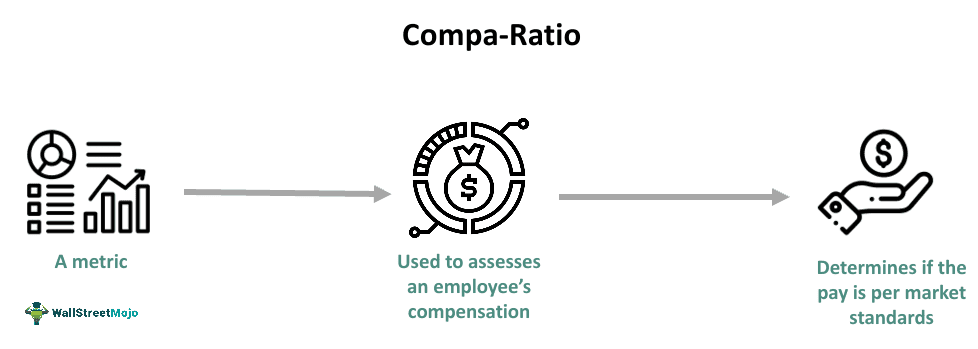Table Of Contents
What Is Compa-Ratio?
A compa-ratio, which is short for compensation ratio, helps organizations or individuals compare an employee’s salary with the average salary in the market for that specific job. Employers can utilize this ratio to make sure their employees’ salaries are consistent with the industry and market standards.

The computation of this ratio helps companies to recruit the best talent, minimize employee turnover, ensure compliance with fair pay policies, and control their payroll expenses. Moreover, it offers useful insight into an organization’s salary strategies. Calculating this metric is a straightforward process. Note that this ratio can be of three types — individual, average, and group.
Key Takeaways
- Compa ratio refers to a metric or formula that allows a person or organization to compare an employee’s salary with a comparative pay target. It helps in managing the pay or remuneration offered to employees within a business.
- There are various benefits of compa-ratio. For example, it provides valuable insight into pay inequality within a certain organization.
- Moreover, business owners or entrepreneurs can utilize this metric to determine how much increment to offer an employee.
- While compa-ratio focuses on a mid-point of a given salary range, range penetration explores the whole pay range.
Compa-Ratio Explained
Compa-ratio refers to a formula or metric that can help professionals compare the salary of any employee to the mid-point of a certain salary range in a target market. Calculating this key metric is important to establish fair compensation for every employee within an organization. If a business’s pay is too little, it risks losing its top talent to competitors. On the other hand, if an organization pays too much, it negatively impacts the bottom line. Thus, computing this metric can help businesses adjust payroll expenses to reduce employee turnover and maintain profit levels.
As noted above, there are three kinds of compa-ratios. Let us understand them:
- Individual: It refers to the relationship between an individual’s salary and a salary range’s mid-point.
- Group: Businesses and individuals can assess the pay of any group of employees within a certain population or a company by utilizing this ratio.
- Average: One can calculate it by determining the sum of all individuals’ compa-ratio and then dividing the result by the total number of persons.
Employers must remember not to base their ratio on any similar job title or any unrelated industry without taking into account the particular job duties. Often, organizations only look at the comparisons concerning job titles without factoring in the qualifications for the job roles or positions they are analyzing.
Formula
The formula used to calculate compa-ratio is as follows:
Compa-Ratio = Current Salary/Market Average or Salary Reference Point x 100
Examples
Let us look at a few compa-ratio examples to understand its calculations better.
Example #1
Suppose the average salary of an accountant in the market is $80,000, and the current salary of Sam, an accountant. To compute the compa-ratio, one must use the above formula.
Compa-Ratio = $80,000/80,000 x 100
As we can see, the ratio is 100%, which indicates that the account receives pay meets the market standards.
Example #2
Software as a service or SaaS-based human capital solution, isolved, introduced its Talent Intelligence and Compensation Analytics solutions. Such solutions are built on benchmark insights. One of their key features is that they enable customers to utilize predictive capabilities for gaining a view into the compa-ratio’s future, the total number of employees receiving salary below or above the salary range’s mid-point, and range penetration distribution.
Advantages
The benefits of compa-ratio are as follows:
- It helps assess whether the compensation allotted for a specific job role is aligned with the market or industry average.
- This metric offers valuable insight regarding pay inequality in a particular organization.
- It can help businesses determine new recruits’ compensation.
- Business owners can utilize this metric to decide what increment to offer their employees.
- One can calculate compa-ratio to compare a subgroup’s actual salary to the average pay of a particular position. Such subgroups may include employee subgroups, units in an entire organization or a department.
- Individuals can use this ratio to determine the competitiveness of their pay to the salary offered by organizations for the same position.
Limitations
Let us look at the disadvantages of this ratio.
- This ratio only factors in the base pay; it does not consider the overall compensation or any other monetary reward that the employees may get.
Compa-Ratio vs Range Penetration vs Position In Range
The concepts of compa-ratio, position in range, and range penetration can be confusing for individuals who are unfamiliar with them. To clearly understand their meaning and purpose and avoid any confusion, one must know their critical differences. So, let us find out what they are.
| Compa-Ratio | Range Penetration | Position In Range |
|---|---|---|
| It focuses on a salary range’s mid-point. | Range penetration focuses on the entire pay range. | It focuses on a pay band’s full spectrum by factoring in both the maximum and minimum of the range. |
| The formula of this ratio has two elements — the current salary and the market average. | The elements of this formula are the current salary, range maximum, and range minimum. | Its formula includes three elements — the pay of the employee, the pay band minimum, and the pay band maximum. |

